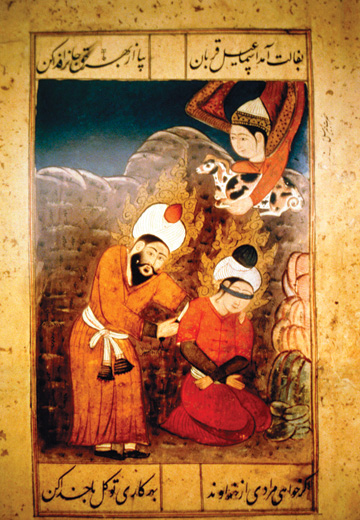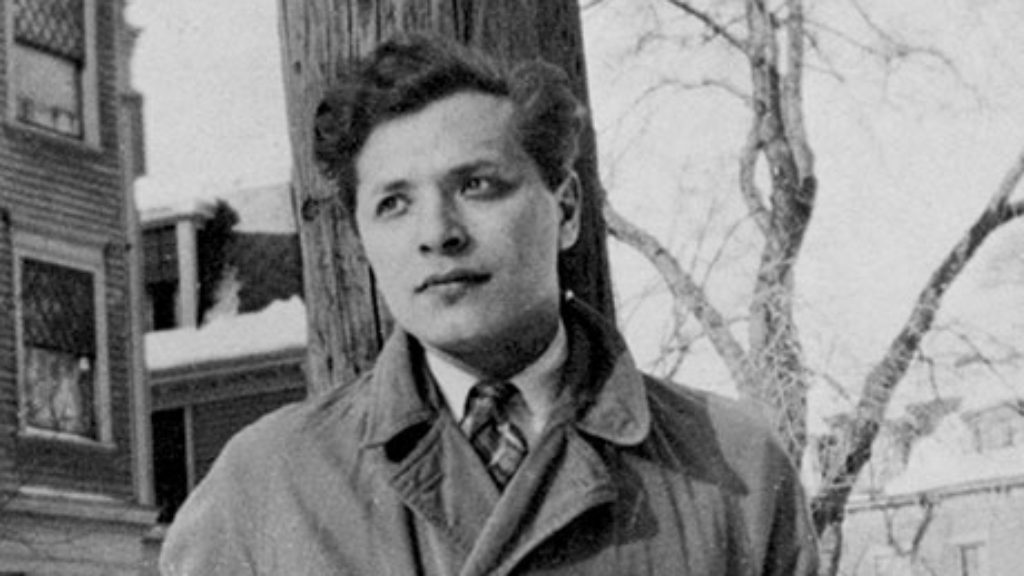Silence of the Lambs
Sacrifice is both foreign and familiar. It is, to say the least, difficult to imagine sacrificing an unblemished one-year-old lamb on an altar together with a vegetable offering and a libation of wine, sprinkling its blood about the altar, and then burning it completely. And yet we continue to speak freely of sacrifice in connection with political and moral obligations, especially here in the United States, where the theme of sacrifice is a staple of public rhetoric and TV drama. Consider just how utterly unsurprising it is that the first official sentence uttered by the just-inaugurated President Barack Obama acknowledged “the sacrifices borne by our ancestors.”
It is tempting to think that the older, biblical notion of sacrifice sheds little light on our current political and ethical use of the term. Two recent books, Moshe Halbertal’s On Sacrifice and James Goodman’s But Where Is the Lamb?, suggest otherwise. Halbertal’s short book combines two linked essays. The first is an investigation into the historical meaning of the religious practice of sacrifice, a phenomenon he dubs “sacrificing to.” The second part of the book is an inquiry into the morality of modern sacrifice, a phenomenon he dubs “sacrificing for.” A central contention of the book is that, beneath all the differences, there lies a deeper conceptual and historical continuity between ancient sacrifice to a God and modern sacrifice for a cause.
Goodman’s book is animated by similar concerns though it is very different. It chronicles many of the diverse ways in which the text of Genesis Chapter 22, the story of Abraham’s near-sacrifice of Isaac, has been interpreted over the past two millennia. His own interest in the story began, he writes, “early in the third millennium. Dark days. Terror attacks had sparked a global war on terror . . . Wherever I turned, I heard the word ‘sacrifice’.” To make some sense of all this, Goodman turned to the history of sacrifice, then to human sacrifice, and finally to Abraham and Isaac, “the ground zero of Western child sacrifice stories.”
The Bible is full of descriptions of sacrificing to. This includes stories, such as the differing fate of the sacrifices of Cain and Abel and the binding of Isaac, along with detailed laws governing the sacrificial offerings in the Tabernacle. A striking feature of both the stories and ritual injunctions is the absence of any explicit rationalization. These texts simply assume that sacrificing to God is a good idea without any explanation as to why. At best, we are given equivocal clues. The smell of the olah or “burnt offering” is often described as pleasing to God, perhaps suggesting that the purpose of the sacrifice is an attempt to curry Divine favor. But not only are there alternate interpretations available, this understanding of the olah is itself explicitly rejected in yet other biblical texts.
From late antiquity on, many biblical commentators, theologians, and modern theorists have attempted to step in and explain the meaning of sacrificing to. Halbertal’s discussion in the first part of his book is best viewed as part of this discussion. Like other theorists (most famously the French anthropologist Marcel Mauss), Halbertal strives to make sense of the act of sacrificing to by treating it as part of an exchange of gifts rather than a market transaction (a bribe, for instance). A core difference between giving and buying is that the former is an expression of the loving relationship that exists between giver and receiver and not, as in the latter, the reason for that relationship. By treating sacrifice as a gift, Halbertal resists the temptation to conceive of it as an attempt to buy God’s favor.
What distinguishes Halbertal’s account from those of other theorists who also understand sacrificing to as being a non-instrumental act of love and gratitude is his focus on the distinctive context in which this particular gift is given. Imagine trying to give a gift to someone who not only has everything, but is also capable of giving anything you could desire in return. In such a context, even when an object is offered as a gift and not a bribe, the asymmetry of power makes it hard to view the relationship in anything other than instrumental terms. Recognizing the constant possibility that what one gives will not be received or that what we hoped would be an act of love turns out to be one of mere utility is profoundly traumatic. Halbertal sees in these anxieties the close connection between sacrificing to and violence.
This dynamic informs Halbertal’s interpretation of the binding of Isaac. One reason that love between non-equals is fraught with anxiety is that neither party can be fully confident that the subordinate doesn’t have ulterior motives. As Halbertal puts it, God in the story emerges as the rich spouse, never sure that he is “not loved for his money.” The only insurance that a gift to God is an expression of love is when what is offered is something whose loss simply cannot be compensated for in any way—in this case Abraham’s son. After Abraham reveals himself willing to offer this gift, God changes his mind, and Abraham sacrifices a ram instead. The sacrificial animal thus becomes a symbolic substitute for the kind of gift for which there can be no compensation.
In his discussion of sacrificing for, the act of “giving up a vital interest for a higher cause,” Halbertal is vividly aware of the dilemmas such acts raise. On the one hand, sacrifice is viewed as a noble act, in which one rejects those courses of action mandated by mere self-interest. For many—including Halbertal—such self-transcendence is the mark of the moral: “without the self freeing himself from his particular interested point of view, there is no moral life.” On the other hand, the preparedness to sacrifice one’s self-interest in the name of some higher cause has been a major source of gruesome acts of violence throughout history and certainly is now. One of Halbertal’s examples is the suicide bomber, whose “act of unleashing violence . . . is simultaneously initiating an act of self-sacrifice and murder.” Thus, while sacrificing for can be noble, it also “mobilizes crimes that in their magnitude are far greater than those motivated by self-interest.”
According to Halbertal, this tension between sacrifice’s noble and nasty possibilities arises because we are tempted by the idea that it is the act of self-sacrifice per se that is morally virtuous, when in fact it all depends on the end for which one sacrifices. This should be obvious, but we are frequently tempted to move from the truism that valuable ends are worthy of sacrifice to the fallacy that that which is sacrificed for is necessarily valuable.
Another mistake is the trickery that guilt plays in the minds of aggressors, leading them to view themselves as the victims when their crime includes some aspect of self-sacrifice. (Halbertal’s chilling example is Himmler’s grotesque portrayal of his SS officers as “selfless beings who made the ultimate sacrifice” in sacrificing their consciences for a greater goal.) Concluding on an explicitly political note, Halbertal observes that these features of human moral psychology have been exploited by the modern state. When it portrays itself as of ultimate value and worthy of sacrifice, it “becomes a false god, providing the loyal citizen a misdirected sense of redemption from his selfish cage.”
At the outset of his book Halbertal expresses the hope that “in following the ways in which various languages have extended the use from one realm [sacrificing to] to another [sacrificing for], we might discover some shared deep structures that encompass rich and diverse realms of human life.” By the end of the book, it turns out that this shared deep structure is “the identification of the sacrifice with the noninstrumental realm.” In both cases, Halbertal suggests, sacrifice takes us away from self-interest.
In the case of sacrificing to, the act of sacrifice is viewed as the free gift of a lover. Halbertal sees sacrificing for as an act of self-transcendence, but love, so central in his discussion of sacrificing to, is notably absent here. Perhaps this is because Halbertal portrays the attitude of sacrificing for as only appropriate in response to the perceived goodness of that for which one is sacrificing—and loving relationships are notoriously impervious to reason.
Is Halbertal correct to mark such a difference between sacrificing to and sacrificing for? I am not so sure. After all, we do often use the language of love in describing acts of sacrificing for as well as sacrificing to, and we do so in a way that implies both disinterestedness and involuntariness. Think of the sacrifices made by parents who choose lives of hardship so that their children can have better futures. The family is a primary example of an object of sacrifice to which we find ourselves bound, and our attitudes toward them do not perfectly track—even in the ideal case—our perception of its value or goodness. If this is right, an alternative reading of the materials that Halbertal assembles suggests itself. Despite their differences, the acts of sacrificing to and sacrificing for do indeed share a common structure: We sacrifice to and for the things we love.
Part of loving a person, community, or ideal consists in the fact that we do not rule out sacrifice to them or for them as a suitable course of action. In this rather more straightforward account, the intimate link between sacrifice (of either kind) and violence is an expression of the intimate, and all too familiar, link between love and violence.
There is an interesting, and perhaps revealing, shift in tone when Halbertal moves from sacrificing to to sacrificing for. Reading the first essay of On Sacrifice was like being in a traditional beit midrash and listening to an exceptionally astute rosh yeshiva expound upon nuances in the meaning of sacred texts. Reading the second part, I was back in the philosophy seminar room, in which an aspect of moral psychology was subjected to a sustained critique through argument and counter-example. There may be good reasons for these methodological choices (as well as his relatively glancing engagement with other theorists), I just wish that Halbertal had been more forthcoming in revealing what they are. It would help in evaluating the persuasiveness of his interpretations.
Despite these reservations, there is no doubt that Halbertal is a master guide through both foreign and familiar terrains. He has the rare ability to revivify arcane topics and texts without sacrificing their complexity on the altar of relevance. The result is a rich and genuinely exciting discussion, one that leaves the philosophically inclined reader with a deep sense that the seemingly narrow and dated topic of sacrifice may be central to contemporary attempts to understand what it is to live a meaningful life.
In But Where Is the Lamb? James Goodman’s focus is not on sacrifice per se, but on the biblical story of a sacrifice that never was: Abraham’s aborted attempt to sacrifice his son Isaac.

Although the story features prominently in the theology, liturgy, and ritual of Judaism, Christianity, and Islam, it is typically treated as a troubling text. Not only does the story itself leave open a number of crucial questions—Why did God issue the command? Why didn’t Abraham protest? Did Isaac know what was happening? Why did the plan seem to change midway? What happened to Isaac at the end?—it also has given rise to conflicting theological lessons, many of which have challenged the moral sensibilities of readers over the centuries. Goodman’s book aims “to shine some light on the long and protean life of nineteen lines of ancient literature.”
The book moves chronologically through a dizzying array of sources, including the Book of Jubilees, Philo and Pseudo-Philo, Josephus, the sages of the Talmud, Syriac hymns, early Christian and Islamic exegetes, the Chronicles of the First Crusades, and medieval English mystery plays. Somewhat closer to home, we encounter Kant and Kierkegaard, Caravaggio and Rembrandt, biblical critics and historians, Shoah literature, feminist commentators, and Israeli poets and novelists. The list goes on, and its sheer length may not seem to provide the raw ingredients required for an engaging or satisfying read. Goodman, however, is a skilled writer who manages to provide just enough contextual and interpretive detail for the reader to see what is at stake in each and every interpretation.
For an outsider to the interpretive tradition such variety will come as a surprise, since it seems obvious that the story promotes a conception of faith as some kind of blind obedience and submission. In reading But Where Is the Lamb?, one quickly sees that things are not so cut and dry. Some read the story as a protest against faith of just that kind, or as a general polemic against the practice of child sacrifice. Others view Abraham as having failed the test precisely because God expected Abraham to protest. Some interpretations proceed by creatively reading between the lines, presenting a hesitant and stalling Abraham, an intervening Sarah, or an all-too-aware Isaac. There are even interpretations in which Abraham succeeds and those in which Isaac runs away.
I have called these “alternatives” in that they run counter to the dominant interpretation, but they are not just dissident positions limited to religious critics and modern readers. Indeed, some of the most extreme re-readings stem from early and traditional interpreters. One of Goodman’s striking examples is the 7th-century piyyut of Johanan Hakohen, which castigates Abraham who:
[D]id not beg for mercy for his only son.
He wished to spill his blood like a cruel man . . .
He should, however, have begged to spare his only son
And save him from the burning coals.
It is worth noting that versions of this piyyut are included in the traditional Ashkenazi prayer ritual and recited to this day in some synagogues as part of the morning service on the festival of Shavuot. (Here, and elsewhere, Goodman is indebted to Shalom Spiegel’s classic study The Last Trial: On the Legends and Lore of the Command to Abraham to Offer Isaac as a Sacrifice.)
It is precisely in the protean life of this ancient story that Goodman finds lessons for present times:
In fact, I couldn’t imagine a better foil for the fiction at the heart of fundamentalism, in all its varieties, than the fluidity, multiplicity, and variety of revelation over time, the thinking and rethinking, the talk and the argument, the writing and rewriting, the vast array and mélange of meanings, the engagement with troubling texts, and the marriage (at times happy, at times troubled, at times both) of tradition and innovation.
Even if one could discern the intended or original meaning of the story, Goodman challenges the desirability of elevating it above others. To do so would be to miss out on century upon century of ingenuity as people attempted to re-imagine the story once again.
Perhaps the most striking and certainly the strangest feature of But Where Is the Lamb? lies in a fantasy told in its opening chapters, where we are introduced to “G”—a ghostwriter Goodman imagines was hired by the biblical editors to help finish up their story of Abraham and who presents them with a working draft of the story of the akedah as a possible grand finale. The editors love the idea and run with the piece, ignoring G’s protests that this draft somehow gets the character of Abraham wrong. G fumes, but his wife reassures him that eventually someone will reinterpret it, and he is partly placated. After all, “it was in the anthology—a great book if ever there was one—to stay, but if at any time people took note of it and were bothered by it, they would revise it . . . Sooner or later, someone would revise it.” Why begin a work of scholarship, even popular scholarship, so fantastically?
Goodman teaches both history and creative writing, and he has clearly thought about different ways of writing non-fiction. His previous book, Blackout, recounts the story of the power outage that took place in New York City in July 1977 by constantly jumping from scene to scene, from encounter to incident to conversation, so as to echo the disorder that characterizes an event taking place in a bustling city of some seven and a half million people. Since no two subjects in the city were looking in exactly the same direction throughout the event and its aftermath, the ambitious narrative form he adopts is one that eschews a single point of view.
At least the characters that feature in But Where Is the Lamb? are all looking in the same direction: toward the 19 verses of Biblical text that are presented (in translation and without comment) at the beginning of the book. The challenge of telling this story is to find a suitable perspective from which to narrate a history of interpretations whose cast traverses such a vast span of time and space without that narrative seeming repetitive or disjointed. At one level, the fantasy of G is Goodman’s writerly response to this challenge. The readers are invited to view the various interpreters of the text from the perspective of an original author eager to see how others improve on the story he was unable to complete. Read this way the fantasy functions as a surprisingly effective rhetorical device. I found myself zipping through the wealth of interpretive detail in each chapter, eager to see just how creatively the challenge had been met in different contexts and religious traditions.
The decision to begin with the fantasy of G is, however, more loaded than I have implied. For Goodman has not simply introduced a point of view from which to narrate, nor has he just planted the idea of an author viewing his interpreters. He has also planted the idea of a flawed story in need of work and a concomitant invitation to the reader to become a co-writer. While reading some of the interpretations on display in But Where Is the Lamb?, I found myself struck by an alternate fantasy, involving not G but G- (pronounced GDash), who is fuming precisely because the perfect morality tale, in which a father’s willingness to sacrifice his son is offered as the paradigm form of religious devotion, is “creatively” misread by subsequent generations unwilling or unable to hear its core message. Like the story of G, the story of G- also introduces the perspective of an author viewing her readers, but the relationship of those readers to G- is not the collaborative partnership between G and his readers but an antagonistic struggle, stemming from the readers’ desire to make best sense of G-’s story in light of their own vision of what constitutes the good life.
As much as Goodman’s subject is the history of interpretation of this particularly troublesome biblical text, it is also a celebration of the distinctive character of the interpretive tradition itself. The creative collaboration between initial author and subsequent interpreters implied by the narrative of G is the way Goodman understands this tradition. But beyond the minimal commitment to take the text seriously was there a basic orientation shared by all of these interpreters across the millennia? Further, even if some interpreters did share a common understanding of their task, Goodman’s own characterization of it as a process of “writing and rewriting” sounds far too contemporary.
These reservations do not undermine Goodman’s achievement. The breadth of resources he draws on, and his own distinctive personal voice, ensure that But Where Is the Lamb? has much to offer the expert reader, while the clarity and playfulness of the prose makes it accessible and engaging to the novice as well. Perhaps the greatest mark of its depth is that, like Halbertal’s On Sacrifice, it leaves the reader convinced that, two millennia later, we are not even close to coming to this story’s end.
Suggested Reading
Like an Echo of Silence
Lea Goldberg’s poetic voice didn’t project outward; it drew the reader in, inviting intimate conversation.

Shifting Sands
Shlomo Sand believes that nations are, in the nature of the case, modern inventions, and that Israel is a particularly bad one.

On a Story by Delmore Schwartz
In 1937, the editors at Partisan Review placed “In Dreams Begin Responsibilities,” by a 24-year old unknown improbably named Delmore Schwartz before pieces by Wallace Stevens, Lionel Trilling, Edmund Wilson, and Pablo Picasso, to relaunch their magazine. They knew what they were doing.

Us or Them
It all started with a tweet: “Curious about your whiteness? Come to our meeting.” Edelman was curious.
Comments
You must log in to comment Log In